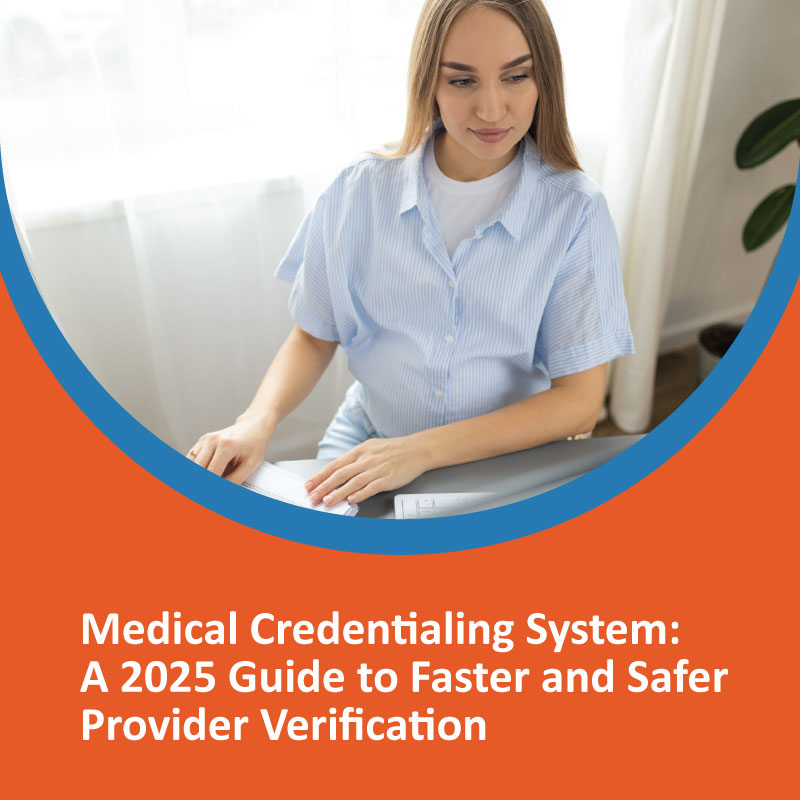In the healthcare industry, credentialing is the first step for a provider being able to practice. This process saves the integrity of your field, ensuring that only competent and qualified individuals are granted the privilege to provide care. The medical credentialing system helps you check if your doctor or service provider is able to provide you with medical services. This ensures the safety of the patient and the quality of healthcare service.
The demand for automated and reliable medical credentialling systems is increasing rapidly due to the expansion of the healthcare industry. Manual credentialing systems were slow and generated errors. They didn’t complete the payer requirements. It was because of low systems. But today, these systems are changing rapidly. Automation helps improve data verification, reduce administrative burdens, and minimise costly delays in provider onboarding.
Read this: Top 7 HIPAA-Compliant Medical Credentialing Companies in the USA in 2025
What Is a Medical Credentialing System?
A medical credentialing system is a specially designed platform used for healthcare organisations. It is used to verify and manage the qualifications, licenses, and work history of medical providers. Its basic purpose is to ensure the authenticity of professionals who are allowed to deliver care and bill insurance companies. Credentialling protects patient safety and supports legal compliance.
Traditionally, this process was done manually. It means they were relying on paperwork, phone calls, and spreadsheets. That’s why they consumed too much time and also caused delays due to errors. But on the other hand, with the invention of the automated medical credentialling system, it became easy. Now, these service providers are directly submitting their applications to insurance companies. In this way, they are saving their time and money and improving their accuracy.
Key Features of a Modern Credentialing Platform
There are some key features of using modern credentialing platforms. These features are as follows.
- The system automatically checks the license and certification dates. It means nothing expires without you knowing.
- It provides real-time updates from trusted sources. It means you don’t have to check things manually.
- It sends reminders before anything expires. It helps you to stay on time with renewals.
- You can apply to insurance companies right through the system. That helps you to make fast approvals.
- All providers’ documents are stored in one place, so it’s easy to find and manage them.
Benefits for Healthcare Providers
There are two major benefits of using a medical credentialing system for healthcare providers. These are as follows.
Improved compliance and reduced errors
Using the best credentialing system helps healthcare providers stay up-to-date with the latest insurance requirements. It is more beneficial in such a case because it reduces the chance of missing deadlines or making manual mistakes. These mistakes can lead to delays, denied claims, or legal problems. By keeping everything organized and automated, healthcare providers can focus more on their patient care and less on paperwork.
Faster onboarding and reimbursement
Credentialing systems speed up the process of getting new providers approved to work and bill insurance companies. Instead of waiting weeks or months, providers can start seeing patients. After seeing their patients, they can receive payments much sooner than before. This faster onboarding means less downtime. It results in quicker cash flow for the practice.
Challenges in Credentialing and How Systems Solve Them
Delayed Approvals and System Alerts
One big problem in credentialing is waiting too long for approvals. This can happen in two cases. One is when paperwork is missing, and the second one is when something is filled out wrong. The quality of a good credentialing system is that it sends alerts when something is incomplete in your documents.
Managing Expiry Dates and Documentation
It can be very hard to keep track of licenses and important documents. If something expires and you don’t know, it can stop a provider from working or billing. To solve this problem, credentialing helps you by sending reminders. They send remainders before things expire and keep all documents in one safe place.
Conclusion
Switching from manual methods to a digital medical credentialing system saves you most of your precious time. It reduces errors and keeps your practice more compliant. Manual methods are slow and risky. But modern systems make the process easier. With features like automatic tracking, providers can focus more on patient care. These systems help them to avoid delays. And also help in missed renewals by sending alerts and reminders. As the healthcare industry is continuously changing and growing rapidly, using the right medical credentialing system will help you to save from a big loss. Moreover, you should also know about the latest policies about credentialing, even if you are a practitioner. Now is the best time to upgrade and stay ahead with a trusted, automated system.
FAQs
Q1. What is meant by a credentialing system platform?
A credentialing platform is a software that allows organizations to manage their website with an online self-service portal. This online platform helps organizations and certified professionals to access and maintain their credentialing records online.
Q2. How does it help with faster insurance approvals?
A medical credentialing system speeds up insurance approvals by sending complete applications directly to insurance companies. It also gives real-time updates. This helps them in fixing issues quickly and avoiding delays.
Q3. Can small practices afford credentialing software?
Yes, small practices can afford credentialing software. It is because many systems are offering low-cost or flexible pricing plans.
Q4. What is meant by a credential management system?
Credential Management, also referred to as a Credential Management System (CMS), is an established form of software that is used for issuing and managing credentials as part of public key infrastructure (PKI).


